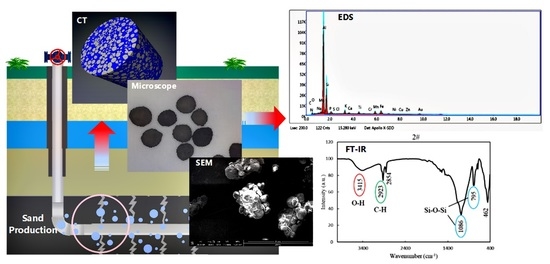Sand Production of the Shale Gas Well in Different Production Periods: Structure and Component
Abstract
:1. Introduction
2. Experimental Section
2.1. Project Overview
2.2. Sand Samples
2.3. Experimental Methods
3. Structure and Composition of the Yielded Sand
3.1. Particle Size Distribution
3.2. CT Scan Analysis
3.3. Microscopic Morphology Analysis
3.4. SEM Observation
3.5. Mineral Component Analysis
4. Discussions
4.1. Source of the Yielded Sand
4.2. Effect of Incomplete Gel Breaking on the Yielded Sand
4.3. Effect of Proppant Embedment on the Yielded Sand
4.4. Difference of the Yielded Sand in Different Production Periods
5. Conclusions
- (1)
- Source of the yielded sand mainly comes from fracturing proppant and shale particles.
- (2)
- Incomplete gel breaking makes the yielded sand to form large-size particles.
- (3)
- Shale particles are generated by hydraulic fracturing and proppant embedment.
- (4)
- Proppant failure during the gas production is also a material source of the yielded sand.
- (5)
- Structure and composition of the yielded sand show obvious differences in different production stages.
Author Contributions
Funding
Institutional Review Board Statement
Informed Consent Statement
Data Availability Statement
Conflicts of Interest
References
- Wang, H.T.; Gala, D.P.; Sharma, M.M. Effect of Fluid Type and Multi-Phase Flow on Sand Production in Oil and Gas Wells. In Proceedings of the the SPE Annual Technical Conference and Exhibition, San Antonio, TX, USA, 9–11 October 2017. [Google Scholar]
- Fan, Z.Q.; Yang, D.Y.; Li, X.L. Quantification of Sand Production Using a Pressure-Gradient-Based Sand-Failure Criterion. SPE J. 2019, 24, 988–1001. [Google Scholar] [CrossRef]
- Huang, F.; Kang, Y.; Liu, H.; You, L.; Li, X. Critical Conditions for Coal Wellbore Failure during Primary Coalbed Methane Recovery: A Case Study from the San Juan Basin. Rock Mech. Rock Eng. 2019, 52, 4083–4099. [Google Scholar] [CrossRef]
- Abass, H.H.; Habbtar, A.H.; Shebatalhamd, A. Sand Control During Drilling, Perforation, Completion and Production. In Proceedings of the Middle East Oil Show, Society of Petroleum Engineers, Manama, Bahrain, 9–12 June 2003. [Google Scholar]
- Walton, I.C.; Chang, F.F.; Lopez de Cardenas, J. Perforation Morphology and the Onset of Sand Production. In Proceedings of the SPE Annual Technical Conference and Exhibition, Society of Petroleum Engineers, Houston, TX, USA, 26–29 September 2004. [Google Scholar]
- Liu, J.; Guo, X.; Liu, Z.; Liu, X.; Liu, Q. Pressure Field Investigation into Oil&Gas Wellbore during Perforating Shaped Charge Explosion. J. Pet. Sci. Eng. 2019, 172, 1235–1247. [Google Scholar]
- Ketmalee, T.; Bandyopadhyay, P. Application of Neural Network in Formation Failure Model to Predict Sand Production. In Proceedings of the Offshore Technology Conference Asia, Kuala Lumpur, Malaysia, 20–23 March 2018. [Google Scholar]
- Zhang, Z.X.; Yang, J.; Zhang, Y.C.; Wang, E.; Meng, W.B.; Qu, X.M.; Zhao, X. Prediction of Sand Production and Optimization of Sand Control Methods in the Production Test Process of Deep Water Gas Wells. In Proceedings of the 54th U.S. Rock Mechanics/Geomechanics Symposium, Physical Event Cancelled, Golden, CO, USA, 28 June–1 July 2020. [Google Scholar]
- Coskuner, G.; Naderi, K.; Babadagli, T. An Enhanced Oil Recovery Technology as a Follow up to Cold Heavy Oil Production with Sand. J. Pet. Sci. Eng. 2015, 133, 475–482. [Google Scholar] [CrossRef]
- Xiong, Y.; Xu, H.; Wang, Y.; Zhou, W.; Liu, C.; Wang, L. Fluid Flow with Compaction and Sand Production in Unconsolidated Sandstone Reservoir. Petroleum 2018, 4, 358–363. [Google Scholar] [CrossRef]
- Wang, L.; Wen, H. Experimental Investigation on the Factors Affecting Proppant Flowback Performance. J. Energy Resour. Technol. 2020, 142, 1–17. [Google Scholar] [CrossRef]
- Hu, J.H.; Zhao, J.Z.; Li, Y.M. A proppant mechanical model in postfrac flowback treatment. J. Nat. Gas Sci. Eng. 2014, 20, 23–26. [Google Scholar] [CrossRef]
- Wan, R.G.; Wang, J. Modelling of Sand Production and Wormhole Propagation in an Oil Saturated Sand Pack Using Stabilized Finite Element Methods. In Proceedings of the Canadian International Petroleum Conference, Calgary, AB, Canada, 8–10 June 2004; p. 43. [Google Scholar] [CrossRef]
- Zhou, Z.Y.; Yu, A.B.; Choi, S.K. Numerical Simulation of the Liquid-Induced Erosion in a Weakly Bonded Sand Assembly. Powder Technol. 2011, 211, 237–249. [Google Scholar] [CrossRef]
- Song, Y.; Ranjith, P.G.; Wu, B. Development and experimental validation of a computational fluid dynamics-discrete element method sand production model. J. Nat. Gas Sci. Eng. 2019, 73, 103052. [Google Scholar] [CrossRef]
- Zheng, H.; Zhang, J.; Qi, Y. Geology and geomechanics of hydraulic fracturing in the Marcellus shale gas play and their potential applications to the Fuling shale gas development. Energy Geosci. 2020, 1, 36–46. [Google Scholar] [CrossRef]
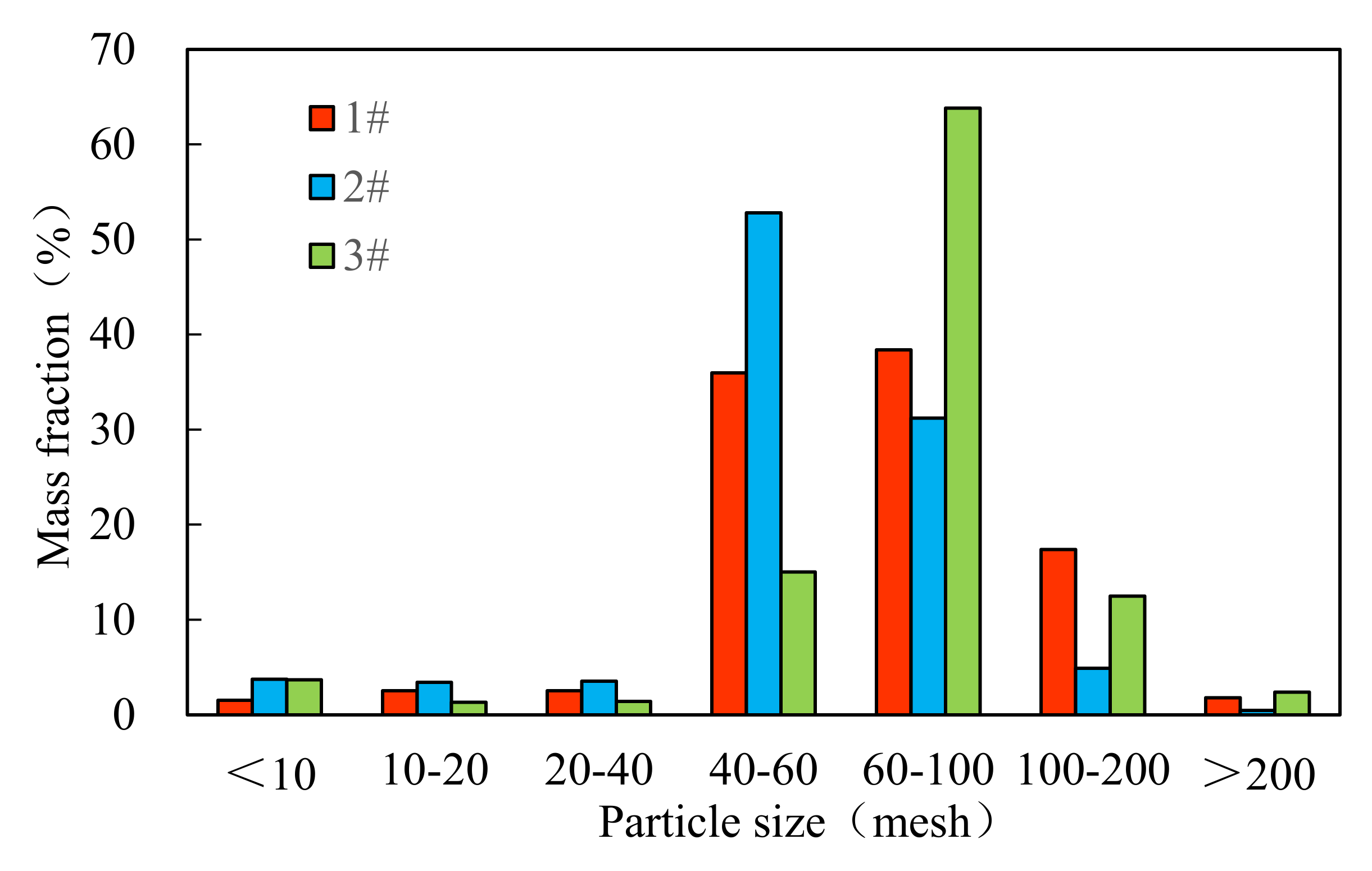

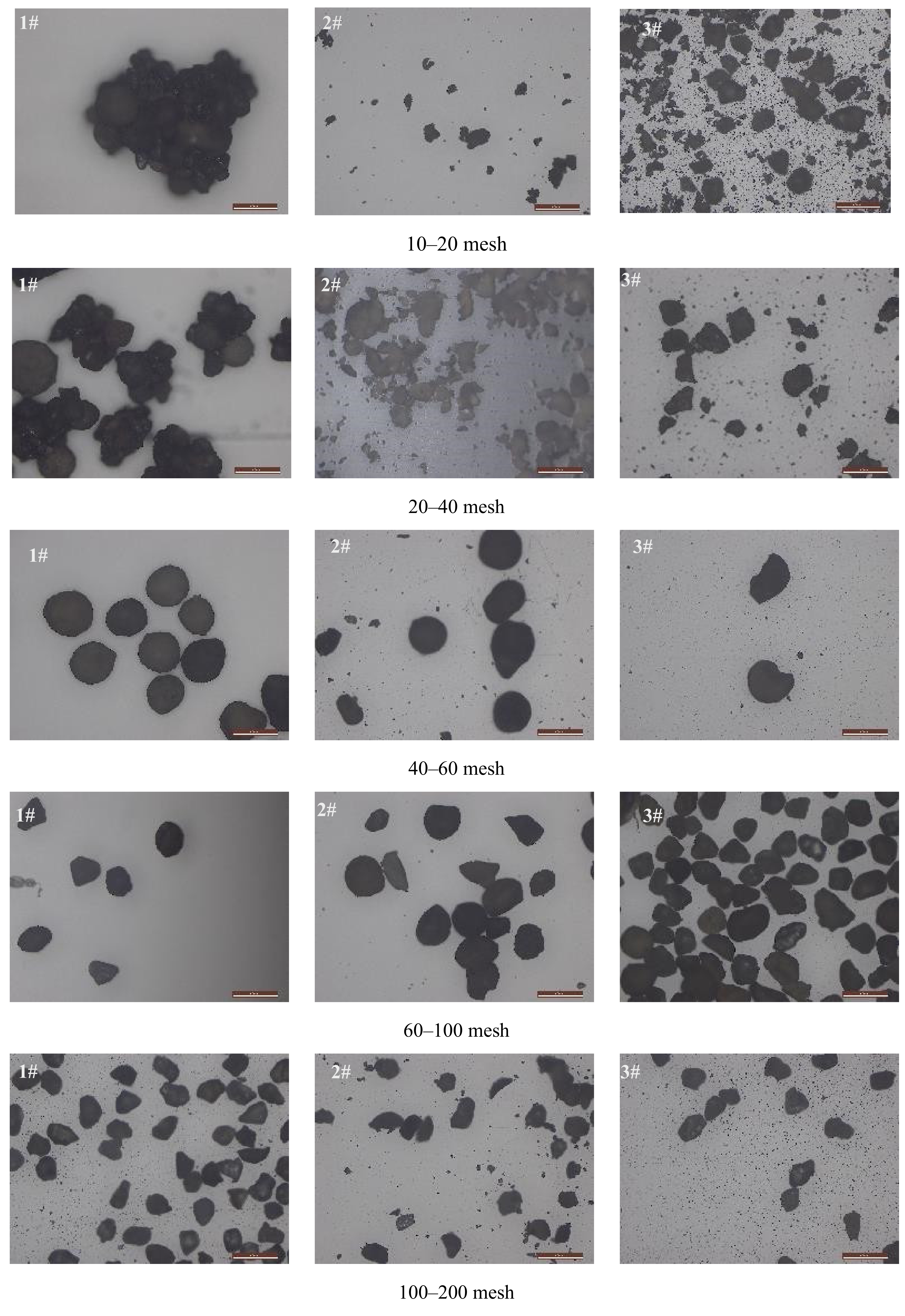
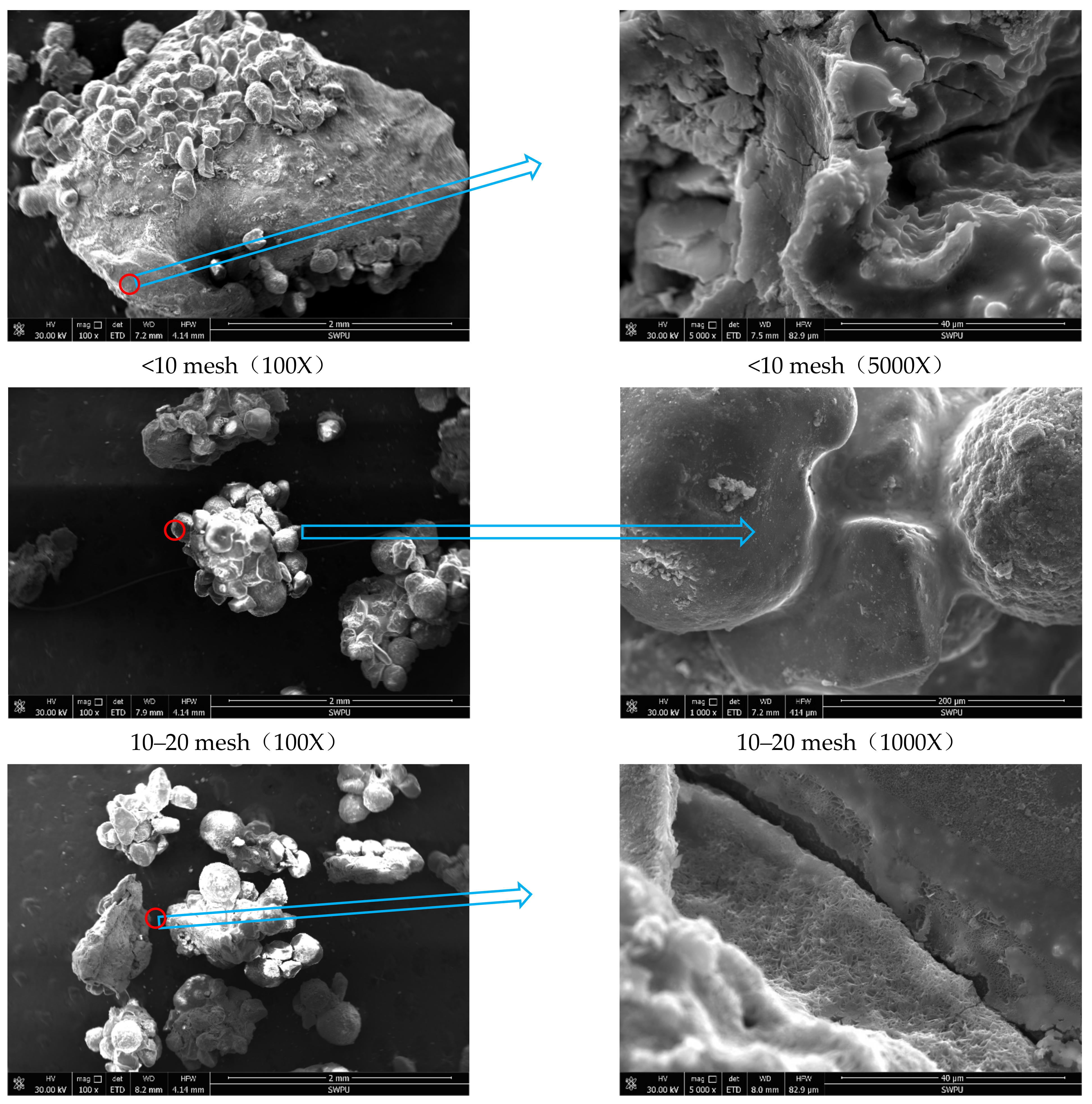
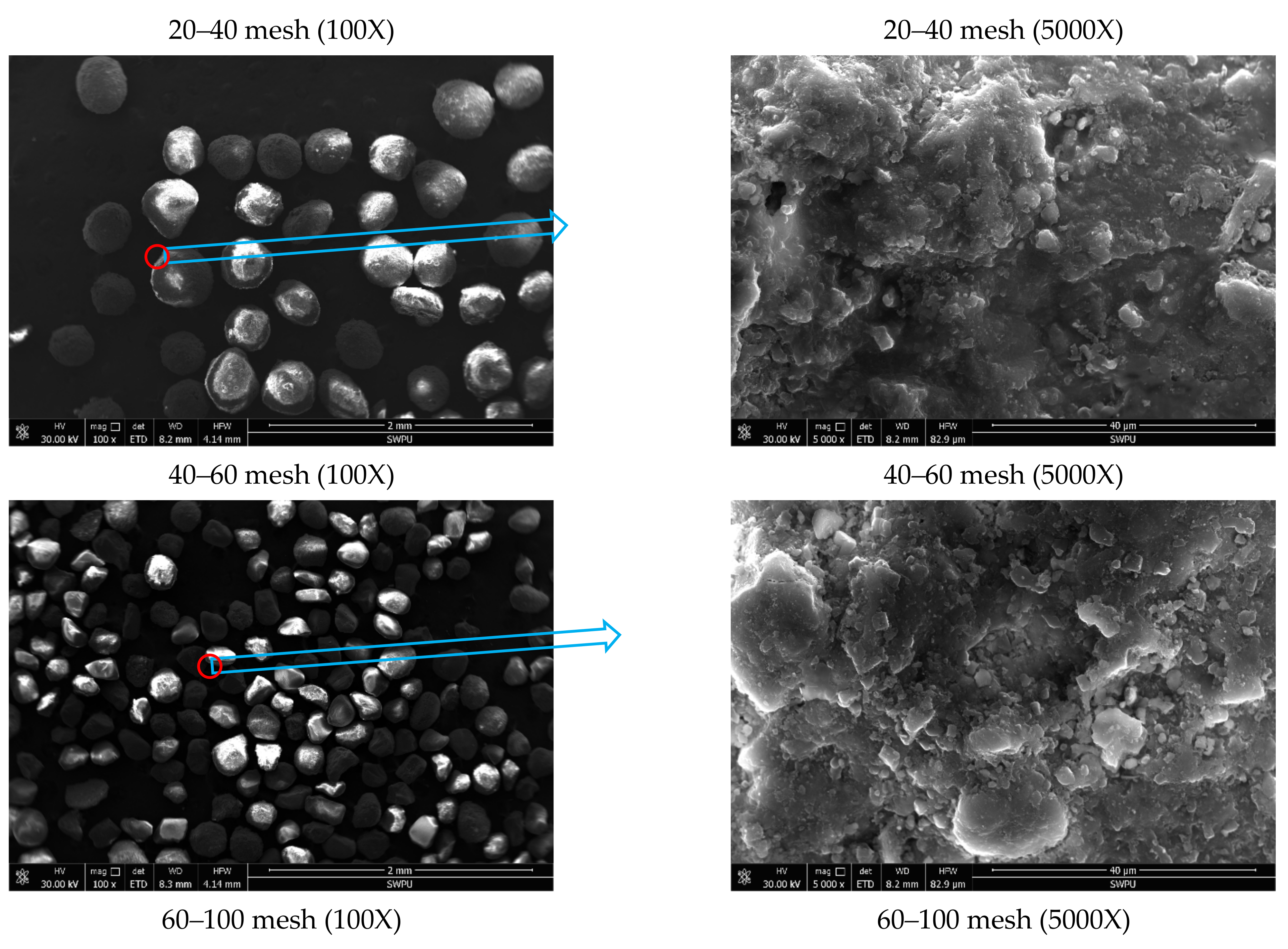




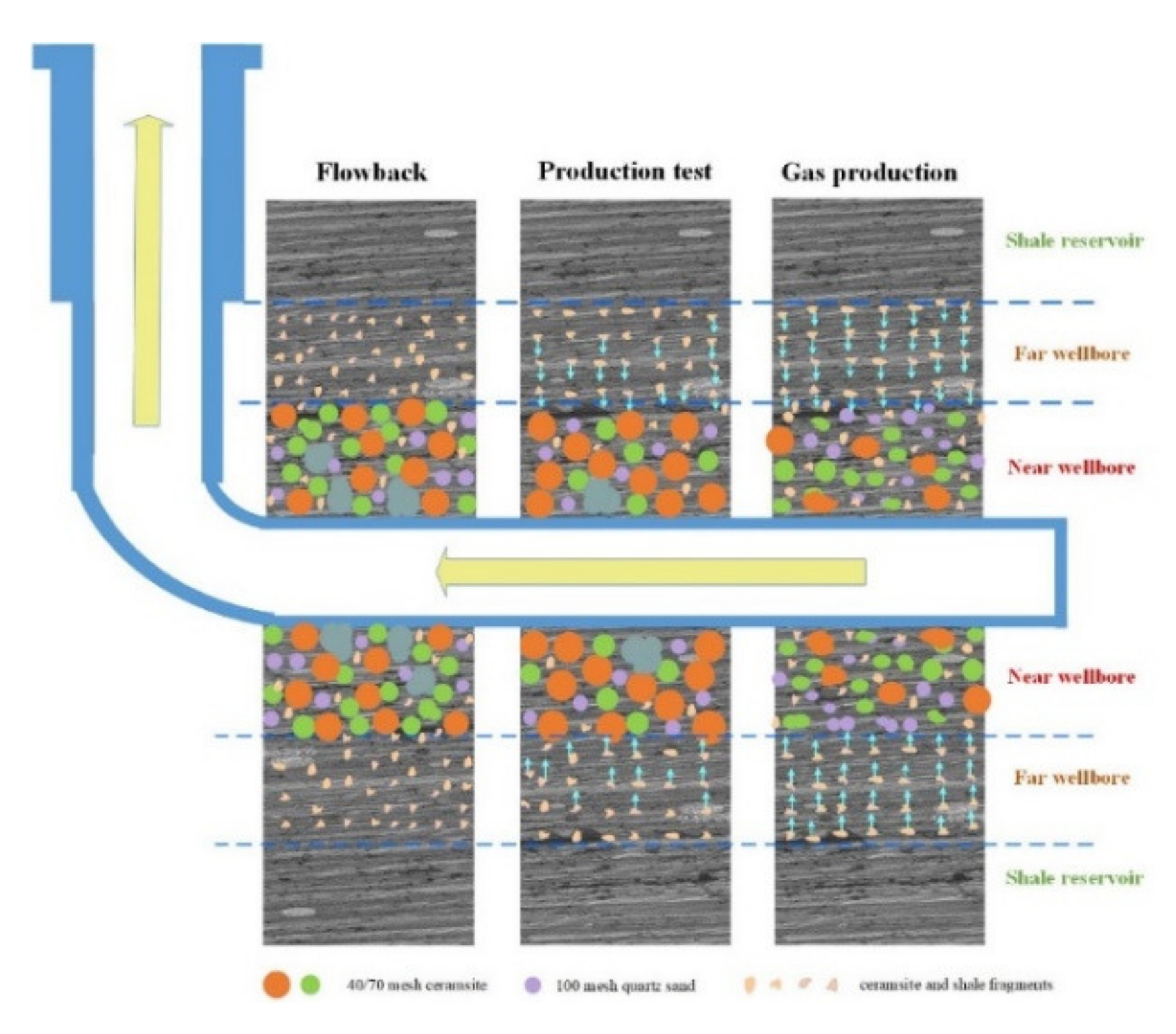
| Sample | Quartz | Feldspar | Corundum | Mullite |
|---|---|---|---|---|
| 1# | 69.1% | 24.6% | 2.8% | 3.5% |
| 2# | 66.1% | 18.8% | 0.5% | 14.6% |
| 3# | 73.6% | 18.5% | 6.0% | 1.9% |
| Element | Content (%) | ||
|---|---|---|---|
| 1# | 2# | 3# | |
| O | 42.7657 | 31.5851 | 31.3945 |
| Si | 34.4903 | 41.6568 | 45.8249 |
| Al | 7.1322 | 9.1742 | 7.7717 |
| C | 6.0555 | 5.5307 | 4.0952 |
| K | 3.2727 | 3.3375 | 3.6574 |
| Fe | 2.7885 | 4.447 | 2.7841 |
| Ca | 1.004 | 1.1933 | 1.2632 |
| Na | 0.8857 | 1.2116 | 1.1104 |
| Ti | 0.6346 | 0.4097 | 0.749 |
| Mg | 0.4086 | 0.1809 | 0.1769 |
| Cl | 0.2851 | 0.5817 | 0.8197 |
| Zr | 0.0886 | 0.0759 | 0.0699 |
| Mn | 0.0855 | 0.2845 | 0.081 |
| Sr | 0.0432 | 0.1022 | 0.0896 |
| P | 0.0305 | 0.1411 | 0.0369 |
| S | 0.0291 | 0.0877 | 0.0756 |
| Material | Quartz Sand | Ceramsite Proppant | Shale | ||||||
|---|---|---|---|---|---|---|---|---|---|
| Compostion | Quartz | Aluminum oxide | Silicate | Ti-Fe oxides | Quartz | Carbonatite | Feldspar | Pyrite | Clay |
Publisher’s Note: MDPI stays neutral with regard to jurisdictional claims in published maps and institutional affiliations. |
© 2021 by the authors. Licensee MDPI, Basel, Switzerland. This article is an open access article distributed under the terms and conditions of the Creative Commons Attribution (CC BY) license (https://creativecommons.org/licenses/by/4.0/).
Share and Cite
Li, X.; Yi, L.; Fan, Z. Sand Production of the Shale Gas Well in Different Production Periods: Structure and Component. Energies 2021, 14, 5588. https://doi.org/10.3390/en14175588
Li X, Yi L, Fan Z. Sand Production of the Shale Gas Well in Different Production Periods: Structure and Component. Energies. 2021; 14(17):5588. https://doi.org/10.3390/en14175588
Chicago/Turabian StyleLi, Xiangchen, Lin Yi, and Zhang Fan. 2021. "Sand Production of the Shale Gas Well in Different Production Periods: Structure and Component" Energies 14, no. 17: 5588. https://doi.org/10.3390/en14175588
APA StyleLi, X., Yi, L., & Fan, Z. (2021). Sand Production of the Shale Gas Well in Different Production Periods: Structure and Component. Energies, 14(17), 5588. https://doi.org/10.3390/en14175588




